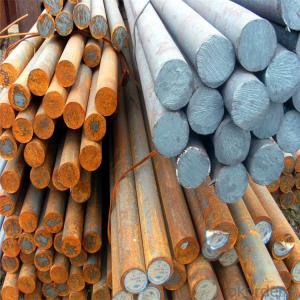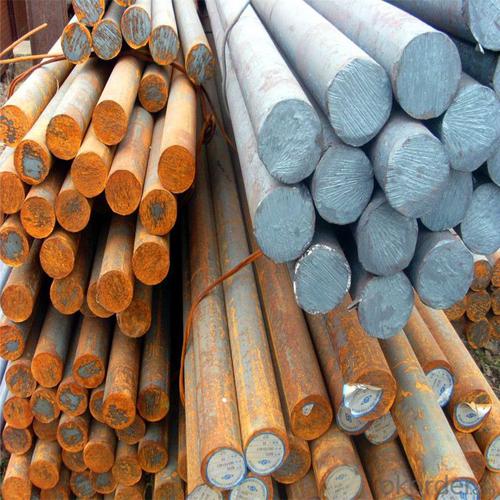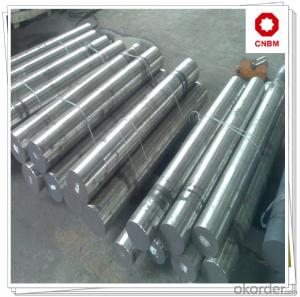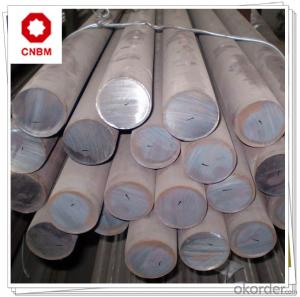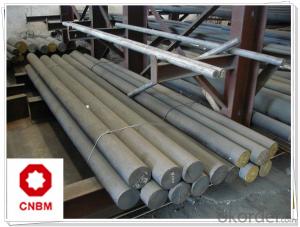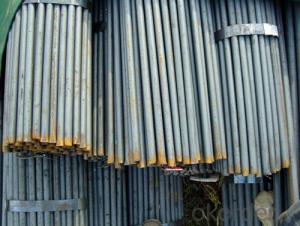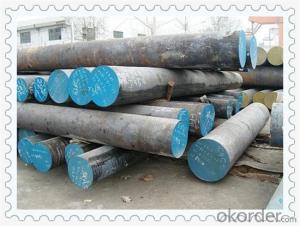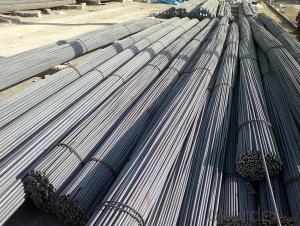Hot Rolled Mild Round Bar S45C C45 1045 CK45 60mm Carbon Steel Round Bar
- Loading Port:
- Tianjin
- Payment Terms:
- TT OR LC
- Min Order Qty:
- 100 m.t.
- Supply Capability:
- 500000 m.t./month
OKorder Service Pledge
OKorder Financial Service
You Might Also Like
Specification
Hot Rolled Mild Round Bar S45C C45 1045 CK45 60mm Carbon Steel Round Bar
Product Description of Hot Rolled Mild Round Bar S45C C45 1045 CK45 60mm Carbon Steel Round Bar
1. Steel grade: ASTM4140, SCM440, 42CrMo, DIN1.7225
2. Length: 6M-12M
3. Diameter: 16mm-300mm
4. Product range: round bar, flat bar, square bar
5. Technique: Hot rolled, forged, cold drawn
Specification of Hot Rolled Mild Round Bar S45C C45 1045 CK45 60mm Carbon Steel Round Bar
Material | SCM4140 | Round bar | Dia(mm) | 16-300mm |
Process | EAF + LF + VD + Forged + Heat Treatment (optional) | Length (mm) | Max 12m | |
Heat treatment | Normalized / Annealed / Quenched / tempered | Flat bar | Thickness(mm) | 8-500mm |
Delivery condition | Hot forged +Rough machined (black surface after Q/T)+ Turned (optional) | Width(mm) | 70-200mm | |
Test | Ultrasonic test according to SEP 1921-84 D/d | Length (mm) | Max 12m |
Chemical Composition of Hot Rolled Mild Round Bar S45C C45 1045 CK45 60mm Carbon Steel Round Bar
C | Si | Mn | Cr | Mo | P | S |
0.38~0.43 | 0.15~0.35 | 0.75~1.00 | 0.8~1.1 | 0.15~0.25 | ≤0.035 | <0.04< td=""> |
Photo Show of Hot Rolled Mild Round Bar S45C C45 1045 CK45 60mm Carbon Steel Round Bar
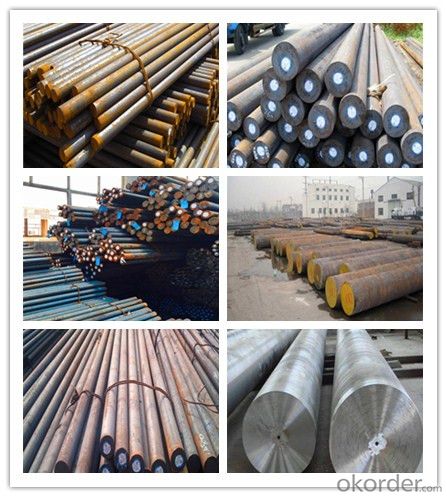
Packing and Delivery:
Packing in bundle package, or as customer's requirements.
Delivery Detail: 45 days after receiving the deposit.
Usage and Applications of Hot Rolled Mild Round Bar S45C C45 1045 CK45 60mm Carbon Steel Round Bar
1. Steel round bar is used in a large number of architectural and engineering structures. Or it can be used in construction of plants for the production of steel house frames, high-voltage transmission towers, bridges, vehicles, boilers, containers, ships, etc.
2. And we can use this kind of product on the performance of the mechanical parts if the demand is not very high.
3. Some special material steel round bar can be used for main shaft of steamer, hummer shank, with big section and supper force.
Company Information
CNBM International Corporation is the most important trading platform of CNBM group.
Whith its advantages, CNBM International are mainly concentrate on Cement, Glass, Iron and Steel, Ceramics industries and devotes herself for supplying high qulity series of refractories as well as technical consultancies and logistics solutions.


F A Q
1, Your advantages?
professional products inquiry, products knowledge train (for agents), smooth goods delivery, excellent customer solution proposale
2, Test & Certificate?
SGS test is available, customer inspection before shipping is welcome, third party inspection is no problem
3, Factory or Trading Company?
CNBM is a trading company but we have so many protocol factories and CNBM works as a trading department of these factories. Also CNBM is the holding company of many factories.
4, Payment Terms?
30% TT as deposit and 70% before delivery.
Irrevocable L/C at sight.
5, Trading Terms?
EXW, FOB, CIF, FFR, CNF
6, After-sale Service?
CNBM provides the services and support you need for every step of our cooperation. We're the business partner you can trust.
For any problem, please kindly contact us at any your convenient time.
We'll reply you in our first priority within 24 hours.
- Q: What are the common applications of steel round bars?
- Steel round bars have numerous common applications across various industries. One common application is in construction, where steel round bars are used for structural support in buildings, bridges, and other infrastructure projects. They are also commonly used in the automotive industry for manufacturing of components such as axles, crankshafts, and suspension systems. Additionally, steel round bars find applications in the manufacturing of machinery, tools, and equipment due to their strength and durability. They are also utilized in the production of furniture, appliances, and various hardware products.
- Q: What are the different types of steel round bars available in the market?
- There are several different types of steel round bars available in the market, each with its own unique characteristics and applications. Some of the most common types include: 1. Mild Steel Round Bars: These are the most commonly used type of steel round bars due to their versatility and affordability. They have a low carbon content and are easy to weld and machine, making them suitable for a wide range of applications. 2. Carbon Steel Round Bars: Carbon steel round bars have a higher carbon content than mild steel, which gives them increased strength and hardness. They are commonly used in applications that require high strength, such as construction and machinery manufacturing. 3. Alloy Steel Round Bars: Alloy steel round bars are made by adding various alloying elements, such as chromium, nickel, or molybdenum, to improve their mechanical properties. These bars offer enhanced strength, toughness, and resistance to wear and corrosion, making them ideal for applications in the aerospace, automotive, and oil and gas industries. 4. Stainless Steel Round Bars: Stainless steel round bars are highly corrosion-resistant due to the presence of chromium, which forms a protective oxide layer on the surface. They are widely used in industries such as food processing, pharmaceuticals, and chemical processing, where resistance to corrosion and hygiene are crucial. 5. Tool Steel Round Bars: Tool steel round bars are specifically designed for tooling applications, such as cutting, drilling, and shaping materials. They have high hardness, wear resistance, and heat resistance, making them suitable for manufacturing tools and dies. 6. Duplex Steel Round Bars: Duplex steel round bars are a type of stainless steel that contains both austenitic and ferritic microstructures. They offer a combination of high strength, excellent corrosion resistance, and good weldability, making them ideal for applications in the chemical and petrochemical industries. These are just a few examples of the different types of steel round bars available in the market. The choice of the right type depends on the specific requirements of the application, including strength, corrosion resistance, machinability, and cost.
- Q: What is the thermal conductivity of a steel round bar?
- The thermal conductivity of a steel round bar may differ based on the particular steel type and composition. In general, carbon steel exhibits a thermal conductivity range of 26 to 48 W/m·K, whereas stainless steel typically has a slightly lower thermal conductivity of 15 to 27 W/m·K. Nevertheless, these values are only approximations and can be influenced by factors including temperature, impurities, and alloying elements. It is worth noting that thermal conductivity describes a material's capacity to conduct heat and is commonly measured in units of W/m·K.
- Q: Can steel round bars be used for shafting applications?
- Yes, steel round bars can be used for shafting applications. Steel round bars are commonly used as shafting material in various industries such as automotive, construction, and manufacturing. They offer high strength, durability, and excellent mechanical properties, making them suitable for transmitting power and rotational motion in machines and equipment. Steel round bars can be machined to precise dimensions, heat-treated for increased hardness, and coated to provide corrosion resistance. Additionally, they are available in different grades and alloys to meet specific application requirements. Overall, steel round bars are a reliable choice for shafting applications due to their inherent strength and versatility.
- Q: How do steel round bars compare to plastic or composite bars?
- Plastic or composite bars cannot match the advantages of steel round bars. Firstly, steel round bars surpass plastic or composite bars in terms of strength and sturdiness. They excel in enduring heavy loads and providing outstanding structural support. Therefore, they are ideal for construction or engineering projects demanding robustness and durability. Secondly, steel round bars exhibit remarkable resistance to impact and wear. They can withstand severe environmental conditions and are less prone to cracking, chipping, or breaking compared to plastic or composite bars. Consequently, steel round bars suit heavy-duty applications where abrasion resistance is crucial. Moreover, steel round bars boast superior heat resistance in comparison to plastic or composite bars. They can endure high temperatures without distorting or compromising their structural integrity. Hence, steel round bars are suitable for applications involving extreme heat, such as machinery or equipment manufacturing. Furthermore, steel round bars are highly versatile and can be easily machined or modified to meet specific requirements. They allow for effortless customization and adaptability through cutting, drilling, bending, or welding. Conversely, plastic or composite bars may have limitations regarding customization or modification. Nonetheless, it is important to consider that steel round bars also have drawbacks when compared to plastic or composite bars. Steel is heavier, which can pose challenges in handling and transportation. Additionally, depending on the specific grade and quality, steel round bars can be more expensive than their plastic or composite counterparts. In conclusion, steel round bars surpass plastic or composite bars in terms of strength, durability, impact resistance, and heat resistance. Although they may have some drawbacks such as weight and cost, their overall performance and versatility make them the preferred choice for numerous high-performance applications.
- Q: Can steel round bars be used for hydraulic cylinder applications?
- Yes, steel round bars can be used for hydraulic cylinder applications. Steel round bars are commonly used in the manufacturing of hydraulic cylinders due to their high strength, durability, and resistance to corrosion. Additionally, steel round bars can be machined to precise dimensions, allowing for the creation of custom hydraulic cylinder components.
- Q: What are the limitations of steel round bars?
- When selecting the appropriate material for a specific application, it is important to consider the limitations associated with steel round bars. Firstly, weight is a significant factor to consider. Steel round bars can be quite heavy, especially in larger diameters. This can pose challenges during transportation and installation, especially in situations where weight restrictions are a concern. Secondly, corrosion is another limitation of steel round bars. Although steel is known for its strength and durability, it is susceptible to rust and deterioration when exposed to moisture or certain chemicals. To mitigate this, protective coatings can be used or stainless steel round bars can be chosen as they are more resistant to corrosion. Thirdly, machinability is a challenge with steel round bars due to their high hardness and strength. This can result in increased tool wear, reduced cutting speeds, and longer machining times, leading to higher production costs. Cost is also an important consideration. Steel round bars, especially those made from high-quality alloys, can be relatively expensive compared to other materials. This cost factor may limit their use in applications with budget constraints. In terms of design flexibility, steel round bars come in standard sizes and shapes, which may restrict design options in some cases. Additional processing steps such as cutting or forging may be necessary to achieve a specific shape or size, adding to the overall production cost. Lastly, fatigue strength is a limitation of steel round bars. Although they have excellent strength properties, they can be prone to fatigue failure under repeated or cyclic loading. This is particularly relevant in applications where the material is constantly subjected to stress or vibration. Despite these limitations, steel round bars are still widely used in various industries due to their exceptional strength, reliability, and versatility. However, it is crucial to carefully consider these factors to ensure that the chosen material meets the specific requirements of the intended application.
- Q: Can steel round bars be used for making mining equipment?
- Yes, steel round bars can be used for making mining equipment. Steel round bars are commonly used in the manufacturing of various mining equipment due to their high strength, durability, and resistance to wear and tear. They are suitable for applications that require heavy-duty and robust equipment, such as drilling rigs, excavators, crushers, and conveyor systems used in the mining industry. The versatility of steel round bars allows them to be machined, welded, and formed into different shapes and sizes, making them ideal for customizing mining equipment to meet specific requirements. Additionally, steel round bars can withstand harsh operating conditions in mining environments, including exposure to abrasive materials, extreme temperatures, and heavy loads.
- Q: Can steel round bars be used in the manufacturing of garden tools?
- Yes, steel round bars can be used in the manufacturing of garden tools. Steel is a durable and robust material that offers strength and resistance, making it suitable for various garden tools such as shovels, rakes, hoes, and spades. The round bars can be shaped and formed to create the desired tool design and functionality, ensuring durability and longevity in outdoor conditions.
- Q: Can steel round bars be used in the chemical industry?
- Indeed, steel round bars find utility in the chemical industry. Owing to its remarkable robustness and endurance, steel is frequently favored for employment in this sector. The construction of storage tanks, pipelines, and equipment within chemical plants often involves the utilization of steel round bars. The material's resistance to corrosion renders it suitable for the handling of diverse chemicals, acids, and alkalis. Furthermore, steel round bars offer exceptional structural reinforcement, a pivotal factor in upholding the integrity and safety of chemical processes. On the whole, steel round bars are an esteemed and extensively employed substance within the realms of the chemical industry.
Send your message to us
Hot Rolled Mild Round Bar S45C C45 1045 CK45 60mm Carbon Steel Round Bar
- Loading Port:
- Tianjin
- Payment Terms:
- TT OR LC
- Min Order Qty:
- 100 m.t.
- Supply Capability:
- 500000 m.t./month
OKorder Service Pledge
OKorder Financial Service
Similar products
Hot products
Hot Searches
Related keywords
